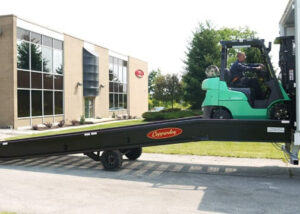Generally, a forklift ramp, slope, or incline exceeds a 10% angle or a rise of approximately one foot per ten feet of ramp or incline. OSHA 1910.178(n)(7) addresses forklift ramps, slopes, and incline regulations that are necessary when heavy machinery is operating on an incline.
On This Page
OSHA Regulations for Ramps
1910.178(n)(7)(i) When ascending or descending grades greater than 10 percent, loaded trucks must be driven with the load facing up the grade.
1910.178(n)(ii) On all grades the load and load engaging means must tilt back if possible and be raised only as far as necessary to clear the road surface.
How a Forklift Ramp Affects Operations

The performance of the machine can be impacted by climbing excessive grades, including battery cycle time, fuel consumption, component temperature, and longevity. As important as it is to be able to successfully climb a ramp, it is equally important to safely descend one when carrying heavy loads. Forklifts must be able to stop completely on a forklift ramp. Ensure that operators follow specific travel rules for their own safety. Forklift operator training is a crucial piece of being safe on a ramp.
A load of a loaded forklift must be pointed up the ramp or slope (good standard practice is to always drive with the load facing up the ramp). The forks should not be raised higher than the height necessary to clear the ground. According to the manufacturer’s specifications, forklifts must be able to stop safely on ramps or slopes.
Forklift Gradeability
Ratings of gradeability are specific to a particular model and make of machine, and are legally available only from the manufacturer. A rating identifies the grade on which the machine is capable of climbing and stopping at full capacity. Using the Toyota 8FBCU25 forklift as an example, its rating is approximately 20%, which is only 12 degrees. Yet, some rough terrain 4-wheel drive forklifts are capable of gradeability ratings of 30-40%.
You can find a ramp’s angle by dividing the rise by the run, then multiplying the result by 100. From the bottom of the ramp to its tallest part, the rise is the height of the ramp. In contrast, the run is its total length.
The formula is (5/50) x 100 = degree of angle. Let’s assume you have a 5-ft. high ramp that runs for 50 ft. In this instance the formula is (5/50) x 100 = degree of angle.
5 / 50 = .1
100 x .1 = 10
As a result of the ramp’s 10° angle, OSHA’s ramp safety guidelines apply.
How To Operate a Forklift on an Incline
Regardless of an operator’s experience, driving a forklift on an incline can be challenging. The good news is that forklift operators who undergo safety training can learn about the risks associated with forklift driving on an incline. The best part is that these operators can learn best practices for driving a forklift up and down ramps and grades.
A driver should review the lift’s operation manual before operating the lift on an incline. It is important for drivers to find out the gradeability of their forklift before driving. A forklift’s gradeability refers to its ability to climb and stop at full capacity at a particular grade on a forklift ramp.
Forklifts with the highest gradeability may have a gradeability of 40%. Forklift drivers should also adhere to OSHA regulations when operating forklifts on a slope. Operators of forklifts on incline surfaces are encouraged to keep a slow speed. It is advisable to follow this practice even when the forklift is not loaded.
Tips for Safely Operating on a Forklift Ramp

As they drive a lift on an incline, forklift operators must continue to proceed with caution. Some best practices include:
-
To prevent a load from falling off the forks, keep the forks tilted upward while carrying a load.
-
Keep the forks pointed downward if there is no load to lift; this will improve the lift’s braking and traction.
-
Avoid sudden changes of direction.
During forklift safety training, drivers learn how to safely operate a lift on an incline. With this training, forklift drivers can consistently find ways to minimize risk to themselves and to others when operating lifts on inclines.

